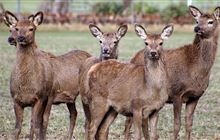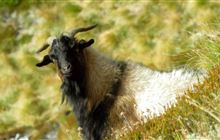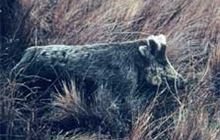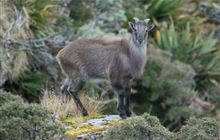Wild Animals Management Programme
Introduction
Our Wild Animals Management Programme manages wild goats, deer, pigs, tahr, and chamois to protect native plants and habitats.Wild goats, deer, pigs, tahr, and chamois eat and damage native plants and habitats – in some places, they threaten how ecosystems function.
Introduced wild animals can:
- change the type and number of plants present,
- change soil qualities
- prevent forest regeneration.
Managing wild animals to reverse these effects will help protect native species and increase forests' health and resilience in dealing with climate change.
DOC monitors sites on public conservation land across the country for the faecal pellets (droppings) of deer, goats, and sheep, tahr, and chamois. This provides our team with an indicator of wild animal numbers. From 2013 to 2022, the number of faecal pellets almost doubled, indicating growth in wild animal populations.
Methods used to manage wild animals
Hunting/shooting
Aerial and ground hunting/shooting are the most common methods used for wild animal management. DOC uses a combination of professional hunters and staff with highly trained indicator or bailing dogs for locating animals for removal. Other methods used are trapping and mustering.
Biosecurity work
Biosecurity measures are used to prevent further introductions, spread of introduced wild animals and remove incursions. Biosecurity work could include fencing, compliance checks for deer farms, or carrying out eradication checks on land that is meant to be free from wild animals.
Research and monitoring
Research and monitoring are used to understand population numbers and impact on plants and ecosystems. They are important tools in wild animal management and used to inform where management occurs.
DOC’s work
DOC is responsible for:
- managing populations of wild goats, deer, pigs, and tahr at priority DOC-managed conservation sites
- taking a leadership role across all land to ensure concerted action against the damaging effects of wild animals on vegetation, soils, waters, and wildlife.
Our Wild Animals Management Programme aims to maintain or achieve wild-animal-free areas, prevent the spread of wild animals into new areas, manage their numbers elsewhere to reduce pressure on native plants and habitats.
Managing populations
Management operations at place for deer, goats, pigs and tahr can differ. DOC’s management approach and priorities are based on factors including:
- the biodiversity value of a site (example: the amount and types of native plants)
- vegetation impacts
- other threats and pressures at a site (example: the presence of possums or the risk of wild animals reinvading from neighbouring land)
- feasibility of carrying out operations (example: what is the terrain like, and how much might an operation cost)
- other conservation activities happening at site.
Coordinating action
Managing wild animals is broader than DOC because they are present across public and private land and there are a range of groups with interests in how they are managed.
DOC has set up a Wild Animal Management National Coordination Group to help coordinate action across the sector. The group is a forum to prioritise and co-ordinate actions for effective wild animal management. There is a diverse range of organisations involved including the conservation sector, hunting sector, Māori organisations, primary industry groups, as well as research institutions.
Related links
Programme summary 2022-23 (PDF, 2,471K)
Subscribe to our e-newsletter and stay up-to-date.
Getting involved
DOC cannot do this work alone. Hunters, landowners, and other agencies can contribute to wild animal management - through working together at place we can make a bigger difference for nature.
There is an opportunity to align hunting efforts with conservation. Hunting is a valued activity in New Zealand, and people hunt deer, goats, and pigs for food, business, and recreation.
Te Ara Ki Mua framework
Te Ara Ki Mua framework is a national framework designed to guide the collaborative effort needed to reduce browsing pressure on our environment from wild deer, pigs, goats, tahr and chamois. It describes actions to achieve the goals of Te Mana o Te Taiao Aotearoa New Zealand Biodiversity Strategy.




